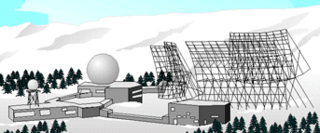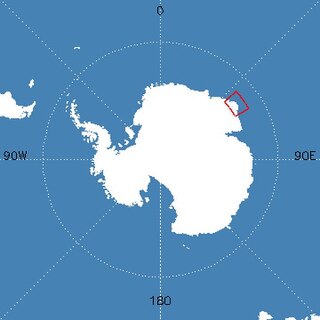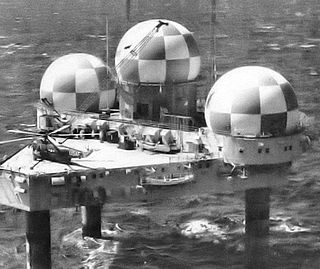
PAVE PAWS is a complex Cold War early warning radar and computer system developed in 1980 to "detect and characterize a sea-launched ballistic missile attack against the United States". The first solid-state phased array deployed used a pair of Raytheon AN/FPS-115 phased array radar sets at each site to cover an azimuth angle of 240 degrees. Two sites were deployed in 1980 at the periphery of the contiguous United States, then two more in 1987–95 as part of the United States Space Surveillance Network. One system was sold to Taiwan and is still in service.

The RCA 474L Ballistic Missile Early Warning System was a United States Air Force Cold War early warning radar, computer, and communications system, for ballistic missile detection. The network of twelve radars, which was constructed beginning in 1958 and became operational in 1961, was built to detect a mass ballistic missile attack launched on northern approaches [for] 15 to 25 minutes' warning time also provided Project Space Track satellite data.

Hanscom Air Force Base (AFB) is a United States Air Force base located predominantly within Bedford, Massachusetts, with portions extending into the adjoining towns of Lincoln, Concord and Lexington. The facility is adjacent to Hanscom Field which provides general aviation and charter service.

Rome Laboratory is a U.S. Air Force research laboratory for "command, control, and communications" research and development and is responsible for planning and executing the USAF science and technology program.

The Electronic Systems Center was a product center of Air Force Materiel Command (AFMC) headquartered at Hanscom Air Force Base, Massachusetts. Its mission was to develop and acquire command and control, communications, computer, and intelligence systems. ESC consisted of professional teams specializing in engineering, computer science, and business management. The teams supervised the design, development, testing, production, and deployment of command and control systems. Two of ESC's most well-known developments were the Boeing E-3 Sentry Airborne Warning and Control System (AWACS), developed in the 1970s, and the Joint Surveillance Target Attack Radar System, developed in the 1980s.

The United States Space Surveillance Network (SSN) detects, tracks, catalogs and identifies artificial objects orbiting Earth, e.g. active/inactive satellites, spent rocket bodies, or fragmentation debris. The system is the responsibility of United States Space Command and operated by the United States Space Force and its functions are:

Over-the-horizon radar (OTH), sometimes called beyond the horizon radar (BTH), is a type of radar system with the ability to detect targets at very long ranges, typically hundreds to thousands of kilometres, beyond the radar horizon, which is the distance limit for ordinary radar. Several OTH radar systems were deployed starting in the 1950s and 1960s as part of early-warning radar systems, but airborne early warning systems have generally replaced these. OTH radars have recently been making a comeback, as the need for accurate long-range tracking has become less important since the ending of the Cold War, and less-expensive ground-based radars are once again being considered for roles such as maritime reconnaissance and drug enforcement.

The Jindalee Operational Radar Network (JORN) is an over-the-horizon radar (OHR) network operated by the Royal Australian Air Force (RAAF) that can monitor air and sea movements across 37,000 square kilometres (14,000 sq mi). It has a normal operating range of 1,000–3,000 kilometres (620–1,860 mi). The network is used in the defence of Australia, and can also monitor maritime operations, wave heights and wind directions.

Cobra Mist was the codename for an Anglo-American experimental over-the-horizon radar station at Orford Ness, England. It was known technically as AN/FPS-95 and sometimes referred to as System 441a; a reference to the project as a whole.

The AN/FPS-117 is an L-band active electronically scanned array (AESA) 3-dimensional air search radar first produced by GE Aerospace in 1980 and now part of Lockheed Martin. The system offers instrumented detection at ranges on the order of 200 to 250 nautical miles and has a wide variety of interference and clutter rejection systems.

Mount Elkins, also known as Jökelen is a dark, steep-sided mountain with three major peaks, the highest 2,300 meters (7,500 ft) above sea level, in the Napier Mountains of Enderby Land. Enderby Land is part of East Antarctica and is claimed by Australia as part of the Australian Antarctic Territory. The mountain was named after Terence James Elkins, an ionospheric physicist with the Australian National Antarctic Research Expeditions at Mawson Station in 1960.

Texas Tower 3 was a former United States Air Force Texas Tower General Surveillance Radar station, first operational in November 1956. The radar station was 50 miles (80 km) southeast of the coast of Nantucket, Massachusetts, in 80 feet of water. The tower was closed in 1963 and dismantled.
John William Marchetti was a radar pioneer who had an outstanding career combining government and industrial activities. He was born of immigrant parents in Boston, Massachusetts, and entered Columbia College and Columbia School of Engineering and Applied Science in 1925. In a six-year program combining liberal arts and engineering, he earned both A.B. and B.S. degrees, followed by the graduate E.E. degree in 1931. He was employed by New York Edison as a power engineer for several years, during which time he also participated in the U.S. Naval Reserve as an Ensign.

Ground Equipment Facility QRC is an FAA radar station that was part of a Cold War SAGE radar station for aircraft control and warning "from Massachusetts to southern Virginia, and as far out to sea as possible." Benton AFS was also the first operational "regional data processing center" for the GE 477L Nuclear Detection and Reporting System.
Columbia Falls Air Force Station is a closed United States Air Force radar station in Washington County, Maine. Located 16.0 miles (25.7 km) northwest of Machias, Maine and 10.0 miles (16.1 km) north of Columbia Falls, it went operational in 1990 but was closed in 1997 and placed in "warm storage" with minimal maintenance. It was deactivated and placed in "cold storage" in 2002.
Moscow Air Force Station is a closed United States Air Force radar station in Somerset County, Maine. Located 6.0 miles (9.7 km) northeast of Moscow, Maine, it went operational in 1990 but was closed in 1997 and placed in "warm storage" with minimal maintenance. It was deactivated and placed in "cold storage" in 2002.
Christmas Valley Air Force Station is a closed United States Air Force radar station. It is located about 16 miles east of the community of Christmas Valley, Oregon. It was closed in 1997.
Laredo Air Force Station was a Cold War radar station of the United States Air Force in Texas.

Eglin AFB Site C-6 is a United States Space Force radar station which houses the AN/FPS-85 phased array radar, associated computer processing system(s), and radar control equipment designed and constructed for the U. S. Air Force by the Bendix Communications Division, Bendix Corporation. Commencing operations in 1969, the AN/FPS-85 was the first large phased array radar. The entire radar/computer system is located at a receiver/transmitter building and is supported by the site's power plant, fire station, 2 water wells, and other infrastructure for the system. As part of the US Space Force's Space Surveillance Network its mission is to detect and track spacecraft and other manmade objects in Earth orbit for the Combined Space Operations Center satellite catalogue. With a peak radiated power of 32 megawatts the Space Force claims it is the most powerful radar in the world, and can track a basketball-sized object up to 22,000 nautical miles (41,000 km) from Earth.
Dr. Robert E. Huffman (1931–2008) was an American space scientist and author. He specialized in ultraviolet spectroscopy in the earth's upper atmosphere. Working for the United States Air Force, Dr. Huffman managed the Horizon Ultraviolet Program (HUP) experiments on two Space Shuttle flights: Columbia and Discovery.















